
 Dansk marine – Ironclad (1868-1907)
Dansk marine – Ironclad (1868-1907)
HDMS Lindormen was a Danish ironclad and monitor built for the Royal Danish Navy in the 1860s, scrapped in 1907. She was perfectly adapted to her role, succeeding to the 1863 Rolfe Krake built in UK, Napier. She was by the way not the very first Danish armoured ship, but its second turret ironclad. In complement, the country already acquired the Broadside ironclads Dannebrog (1863), Peder Skram (1864) and Danmark (1864) the latter built at Thomson with an iron hull, and the former at Copenhagen Yard, with wooden hulls. So Lindormen became the most modern vessel of the entire navy, and her classification by many authors as monitor reflected her single twin turret (two on Rolfe Krake). This was also the most modern ship ever built at Copenhagen Royal Naval Yard and Arsenal. She was followed by a relatively long line of similar ships, Grom (1870), Odin (1872), Helgoland (1878), before a first true coastal battleship, Iver Hvitfeldt, in 1886.
Note: She was named after the famous mythological serpent of the Sagas.
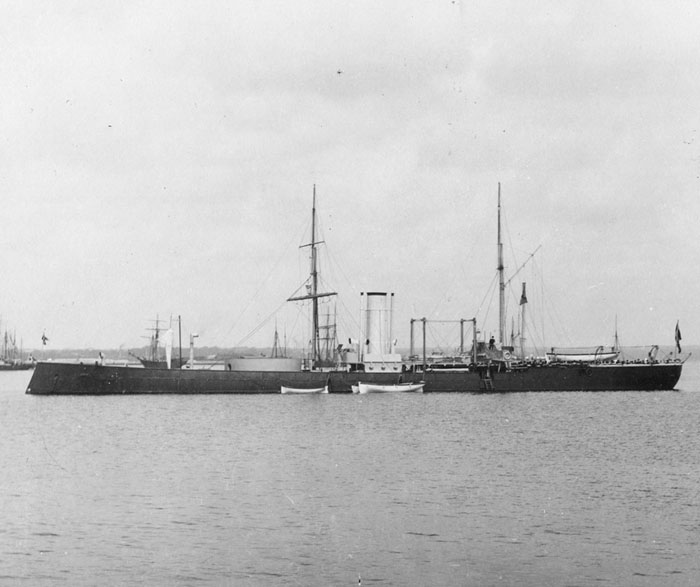
Lindormen in traditional livery with dark hull and yellow funnel and structures. Her brick type rigging was just an afterthough, a safety in case of steam engine failure as customary at the time.
Design of the class
Hull and general design
Lindormen displaced 2,048 metric tons (2,016 long tons) standard (fully loaded unknown). Her hull measured 66.62 meters (218 ft 7 in) in overall length, beam 11.99 meters (39 ft 4 in) and relatively low draft of 4.44 meters (14 ft 7 in), good for the shallow waters of the region. Complement consisted in 150 officers and ratings.
Powerplant
HMDS Lindormen was powered by two shafts, linked to two horizontal direct-acting steam engines. The latter were provided by Danish manufacturer Burmeister & Wain. The large propeller shafts were bronze-made, four bladed, diameter c3 meters. Total output as indicated was 1,500 ihp (1,100 kW). Designed speed was 12.5 knots (23.2 km/h; 14.4 mph). Seaz trials speed not known. Lindormen carried a maximum for range some 125 metric tons (123 long tons; 138 short tons) of coal for 1,400 nmi (2,600 km; 1,600 mi) at 8.5 knots (15.7 km/h; 9.8 mph). This was largely sufficient for the extent of the western Baltic, North Sea, and maze of islands close to the Skagerrak.
Armament
This armament was revised in 1874, 1880, 1881 and 1886 to stay relevant:
-Single turret, 2x 229 mm (9 inches)/14 Model 1868 kept until her decommission
-2x Danish 83 mm Rifled guns (1874)
-2x Bofors 87 mm added (1880)
-4x 37 mm Hotchkiss QF (2 pdr) (1881)
-4x 87 mm Bofors rifled breechloaders (1886)
Main
While previous HDMS Rolf Krake had two twin turrets, Lindormen was made with a single twin turret, as it’s simplified the design and weight balances, but this turret was far larger, heavier to house the most powerful guns ever made for Denmark, two 22.9 cm rifled guns. In British nomenclature, they were referred as “90 pounders” (based on the shell weight), or more generally assimilated to 254 centimeters but in reality were closer to 229 mm. These were short guns, 14 caliber, tailor-made for the Danish turret, so model 1868.
In 1876, the Navy dropped the shell weight as measure and instead used shell diameter to avoid confusion, no in millimeters but in British inches, and in this case “Nine inches”. As the Dansk Arsenalen had no experience in casting such large, modern guns, they were ordered to Armstrong in Elswick (near Newcastle). These rifled muzzle-loading guns could fire a salvo about every four minutes.
Secondary
For secondary artillery, historian and author Steensen mentions four 4-pounder smoothbore howitzers. These were intended to be taken aboard Lindormen’s boats for a landing party but were not used for saluting and for fighting smaller ships. On her maiden voyage in the autumn of 1870, the ironclad obtained a newly purchased Swedish 4-pounder or 83 mm L/17, mounted aft. By December 1870, the Ministry of the Navy decided she would be only equipped with light guns of this type or similar. From 1874, HDMS Lindormen had two of these.
In 1880 these two light guns were replaced by two 87mm rifled Krupp breechloaders.
In 1903, close to decommission, the Naval Ministry decided her whole battery would be upgraded in connection to a last overhaul modernization, but this never took place. So in the end she still hade her original main battery
Light
When the threat from torpedo boats in the late 1870s, a set of modern QF guns were purchased by the ministry: A 25 mm “mitrailleuse” (French term used here in Danish) from the Swedish manufacturer Palmcrantz as well as a 37 mm revolver cannon from French Hotchkiss. The mitrailleuse was tested on board the gunboat Falster by the summer of 1879 and the revolver gun on Lindormen during squadron service at the same time. Based on these, the Navy preferred the Hotchkiss revolver guns, so from 1881 Lindormen had four of these installed. In 1893-1898, an 11 mm cal. Nordenfeldt mitrailleuse was also installed to round up this light battery.
Protection
Lindormen was iron hulled, with a complete waterline armored belt 127 mm (5 in) in thickness, whereas her gun turret had 140 mm (5.5 in) armor plating for walls. The foor was probably lightly protected. She also had a conning tower which walls were 127 mm or 5-inches in thickness.
⚙ specifications as built 1869 |
|
| Displacement | 2,048 metric tons (2,016 long tons) |
| Dimensions | 66.42 x 11.9 x 4.449m (217 ft 11 in x 39 ft 4 in x 14 ft 7 in) |
| Propulsion | 2 shafts, 2 direct-acting steam engines 1,500 ihp (1,100 kW) |
| Speed | 12.5 knots (23.2 km/h; 14.4 mph) |
| Range | 1,400 nmi (2,600 km; 1,600 mi) at 8.5 knots (15.7 km/h; 9.8 mph) |
| Armament | 2 × Armstrong 9-inch (229 mm) rifled muzzle-loading guns |
| Protection | Belt: 127 mm (5 in), Gun turrets: 140 mm (6 in), Conning tower: 127 mm (5.0 in) |
| Crew | 150 |
Career of HDMS Lindormen
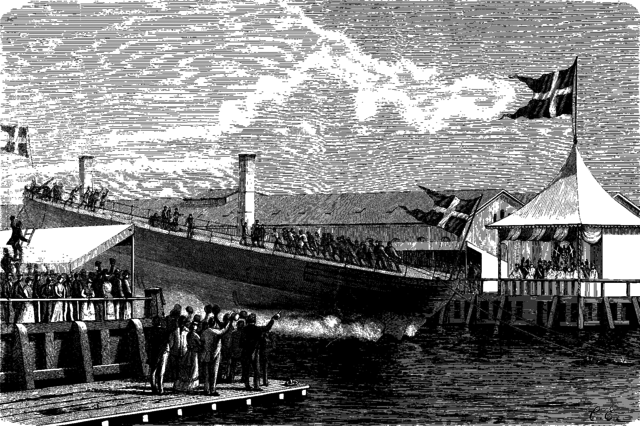
Lindormen was laid down at the Naval Dockyard in Copenhagen, on 20 July 1866. She was launched on 8 August 1868, completed on 15 August 1869.
In June-September 1870, she was in squadron with the armored ships Dannebrog and Peder Skram and made later a second cruise. By June-September 1872, she was part of the main Danish squadron with HDMS Rolf Krake, Gorm, Absalon and Esbern Snare. By September-October 1873, she trained with Rolf Krake, Gorm and the gunboat Buhl. September-October 1874 saw her operating with Odin, Gorm and the gunboat Willemoes in the North sea. By August-October 1875, she had exercises with Odin, Gorm and the screw corvette Hejmdal, she also trained with the gunboat division (Willemoes, Falster, Øresund and Store Bælt).
By September-October 1877, she trained Odin, Gorm, Absalon and Willemoe and at the same period in 1879, with the brand new Heligoland, and same Odin and Absalon, same in 1881 (she had a drydock refit in 1880). Same period in 1882, she had her yearly manoeuvers with HDMS Odin, Gorm and Absalon.
By August-October 1885, she served with Odin, Gorm, Falster, the new Esbern Snare, and three torpedo boats: Hvalrossen, Delfinen and Sværdfisken. This was the first time she trained with and to counter torpedo boats.
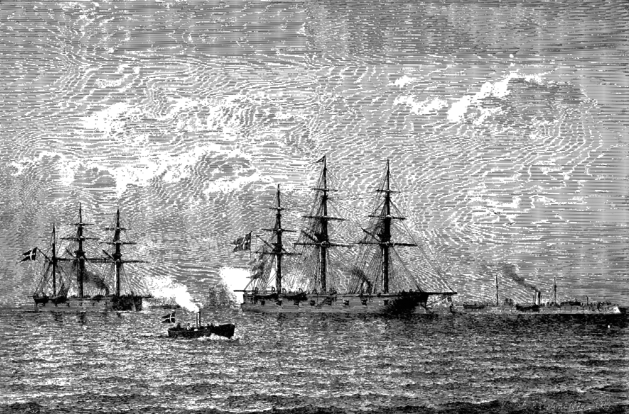
Live illustration (engraving) at Tidende, Carl Baagøe’s drawing, which closely followed the fleet’s operations. Here you can see the Lindormen on the right of the squadron in 1870. The two others are broadside ironclads.
In June-October 1889, again she served with Gorm, Absalon, but also Møen, Øresund, Store Bælt and Lille Bælt. August saw the main squadron expanded with the torpedo boats Hajen, Søulven, Nr. 6, 7, 9, 10, 11, 12, 13 and Patrouillebaad No. 3 and 4. There were a few replacements, until the unit was disbanded on 3 October 1889.
HDMS Lindormen was then laid up, decommissioned on 29 June 1907 and stricken the same day, then sold together with Rolf Krake. The two were towed to Dordrecht, Netherlands to be broken up.
Thus, if she took no part in WWI, she provided the coastal defence of Denmark for decades, training yearly with a protective squadron.
Read More/Src
Books
Balsved, Johnny E. “LINDORMEN (1869–1907)”. Danish Naval History.
Gardiner, Robert, ed. (1979). Conway’s All the World’s Fighting Ships 1860–1905. Greenwich: Conway Maritime Press.
Silverstone, Paul H. (1984). Directory of the World’s Capital Ships. New York: Hippocrene Books.

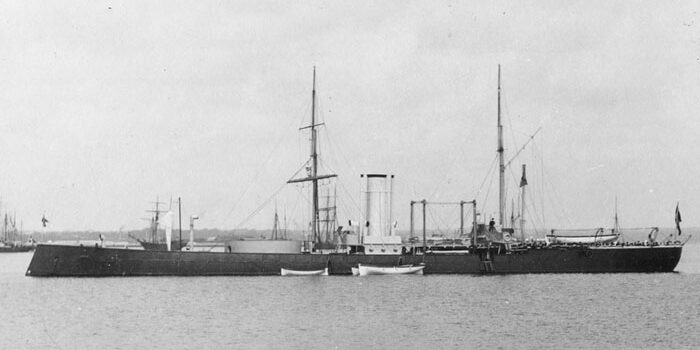
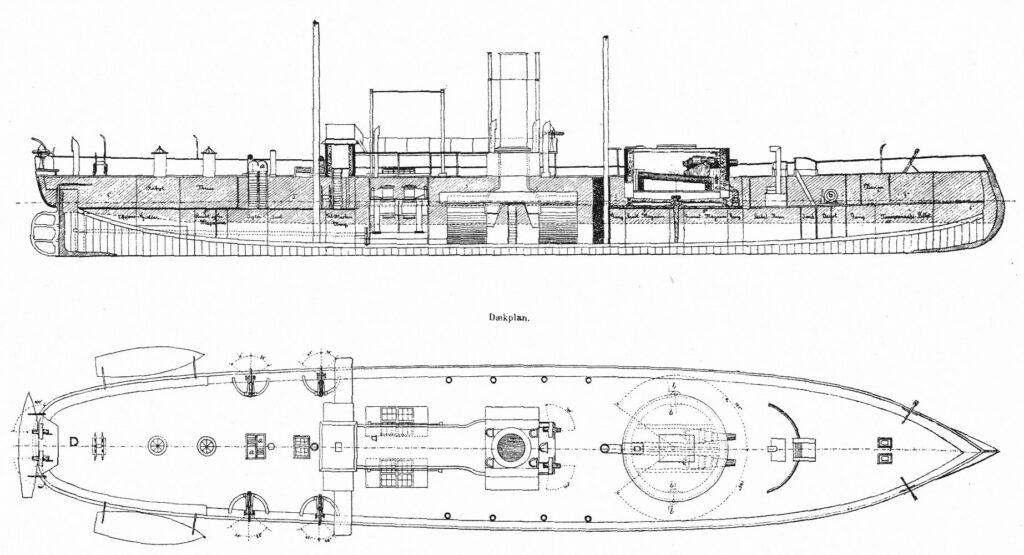
 Latest Facebook Entry -
Latest Facebook Entry -  X(Tweeter) Naval Encyclopedia's deck archive
X(Tweeter) Naval Encyclopedia's deck archive Instagram (@navalencyc)
Instagram (@navalencyc)





 French Navy
French Navy Royal Navy
Royal Navy Russian Navy
Russian Navy Armada Espanola
Armada Espanola Austrian Navy
Austrian Navy K.u.K. Kriegsmarine
K.u.K. Kriegsmarine Dansk Marine
Dansk Marine Nautiko Hellenon
Nautiko Hellenon Koninklije Marine 1870
Koninklije Marine 1870 Marinha do Brasil
Marinha do Brasil Osmanlı Donanması
Osmanlı Donanması Marina Do Peru
Marina Do Peru Marinha do Portugal
Marinha do Portugal Regia Marina 1870
Regia Marina 1870 Nihhon Kaigun 1870
Nihhon Kaigun 1870 Preußische Marine 1870
Preußische Marine 1870 Russkiy Flot 1870
Russkiy Flot 1870 Svenska marinen
Svenska marinen Søværnet
Søværnet Union Navy
Union Navy Confederate Navy
Confederate Navy Armada de Argentina
Armada de Argentina Imperial Chinese Navy
Imperial Chinese Navy Marinha do Portugal
Marinha do Portugal Mexico
Mexico Kaiserliche Marine
Kaiserliche Marine 1898 US Navy
1898 US Navy Sovietskiy Flot
Sovietskiy Flot Royal Canadian Navy
Royal Canadian Navy Royal Australian Navy
Royal Australian Navy RNZN Fleet
RNZN Fleet Chinese Navy 1937
Chinese Navy 1937 Kriegsmarine
Kriegsmarine Chilean Navy
Chilean Navy Danish Navy
Danish Navy Finnish Navy
Finnish Navy Hellenic Navy
Hellenic Navy Polish Navy
Polish Navy Romanian Navy
Romanian Navy Turkish Navy
Turkish Navy Royal Yugoslav Navy
Royal Yugoslav Navy Royal Thai Navy
Royal Thai Navy Minor Navies
Minor Navies Albania
Albania Austria
Austria Belgium
Belgium Columbia
Columbia Costa Rica
Costa Rica Cuba
Cuba Czechoslovakia
Czechoslovakia Dominican Republic
Dominican Republic Haiti
Haiti Hungary
Hungary Honduras
Honduras Estonia
Estonia Iceland
Iceland Eire
Eire Equador
Equador Iran
Iran Iraq
Iraq Latvia
Latvia Liberia
Liberia Lithuania
Lithuania Mandchukuo
Mandchukuo Morocco
Morocco Nicaragua
Nicaragua Persia
Persia San Salvador
San Salvador Sarawak
Sarawak Uruguay
Uruguay Venezuela
Venezuela Zanzibar
Zanzibar Warsaw Pact Navies
Warsaw Pact Navies Bulgaria
Bulgaria Hungary
Hungary

 Bundesmarine
Bundesmarine Dutch Navy
Dutch Navy Hellenic Navy
Hellenic Navy Marina Militare
Marina Militare Yugoslav Navy
Yugoslav Navy Chinese Navy
Chinese Navy Indian Navy
Indian Navy Indonesian Navy
Indonesian Navy JMSDF
JMSDF North Korean Navy
North Korean Navy Pakistani Navy
Pakistani Navy Philippines Navy
Philippines Navy ROKN
ROKN Rep. of Singapore Navy
Rep. of Singapore Navy Taiwanese Navy
Taiwanese Navy IDF Navy
IDF Navy Saudi Navy
Saudi Navy Royal New Zealand Navy
Royal New Zealand Navy Egyptian Navy
Egyptian Navy South African Navy
South African Navy






























 Ukrainian Navy
Ukrainian Navy dbodesign
dbodesign